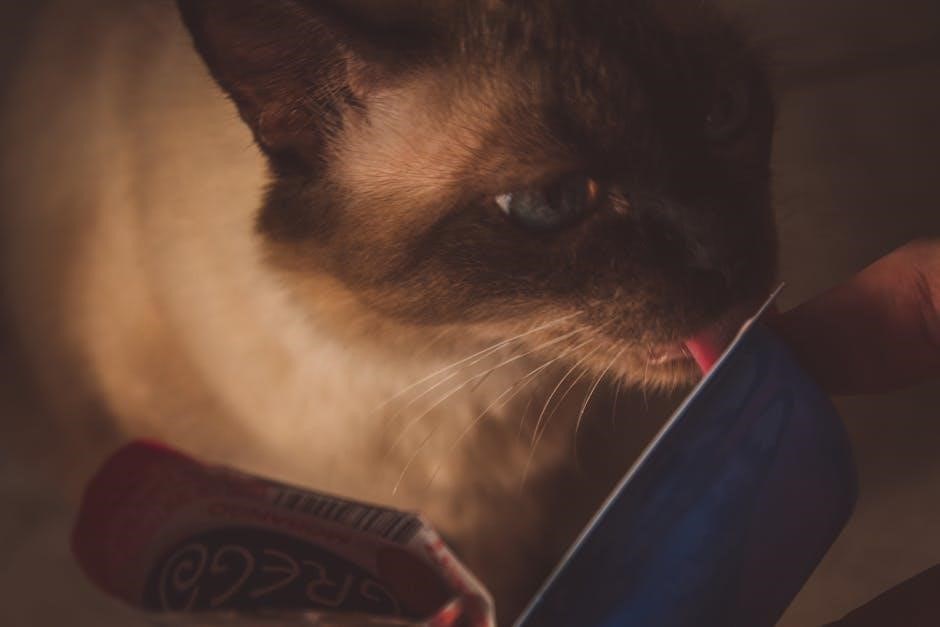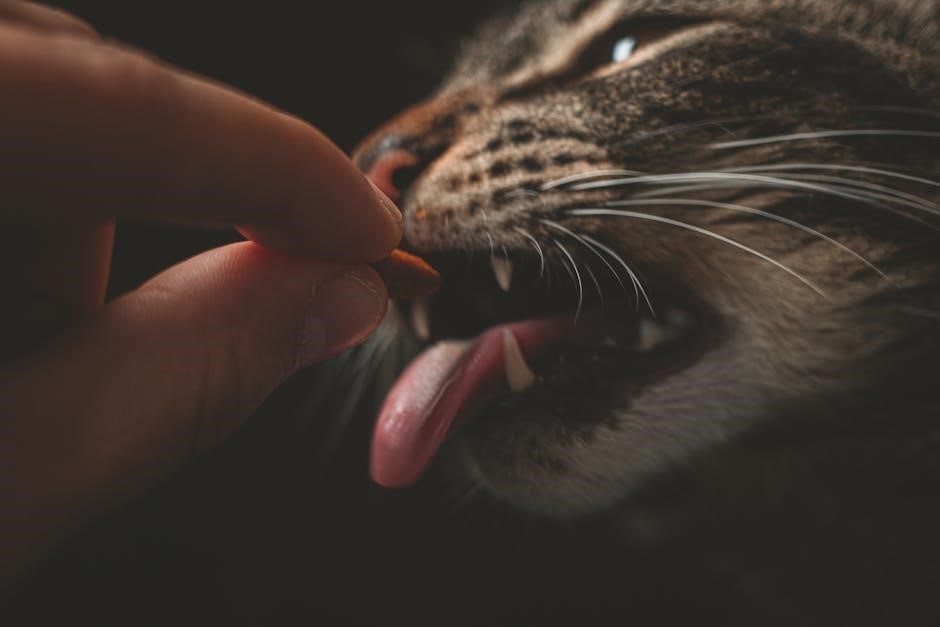
Kitten Milk Replacer (KMR) is a nutritious formula designed for orphaned or motherless kittens, providing essential nutrients for healthy growth and development․ It closely mimics a mother’s milk, ensuring proper digestion and hydration․
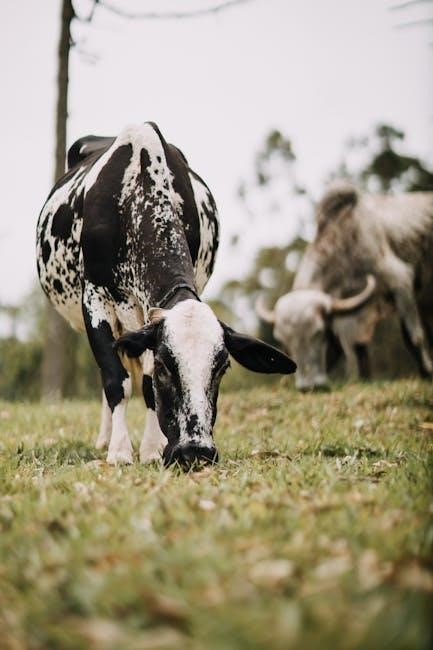
Ingredients in KMR
KMR contains high-quality proteins, essential fats, vitamins, and minerals, along with taurine, an amino acid vital for heart and eye health․ These ingredients mimic a mother’s milk, ensuring proper kitten development․

2․1 Proteins
Proteins in KMR are essential for kitten development, providing the building blocks for muscle growth and tissue repair․ High-quality protein sources, such as casein and whey, are easily digestible and mimic a mother’s milk composition․ These proteins support overall growth, ensuring kittens develop strong muscles and thrive․ Proper protein intake is critical during the first few weeks of life, as it directly impacts weight gain and energy levels․ KMR formulas typically contain at least 30% protein on a dry matter basis, meeting the nutritional needs of neonatal kittens․ Proteins also play a role in maintaining healthy skin and coat condition․ Ensuring adequate protein intake helps prevent growth retardation and supports immune function․ For orphaned kittens, the protein in KMR is vital, as they rely solely on this formula for nutrition․ Always choose a KMR with high-quality, bioavailable proteins to ensure optimal health and development․ This makes KMR indispensable for caregivers of young, motherless kittens․
2․2 Fats
Fats are a critical component of KMR, serving as a primary energy source for kittens․ They support rapid growth and development, particularly in the brain and nervous system․ KMR typically contains 20-25% fat on a dry matter basis, ensuring kittens receive the energy they need to thrive․ These fats are balanced to prevent obesity while meeting the high metabolic demands of young kittens․ Essential fatty acids, such as linoleic acid, are included to support skin health and coat condition․ Fats also enhance the absorption of fat-soluble vitamins, like A, D, and E, which are vital for immune function and overall health․ High-quality KMR formulas use animal-based fat sources, which are more bioavailable than plant-based alternatives․ Proper fat content ensures kittens maintain healthy weight gain and energy levels, avoiding deficiencies that could hinder development․ This balanced approach makes KMR an ideal substitute for a mother’s milk, providing all the necessary nutrients for optimal growth․
2․3 Vitamins and Minerals
Vitamins and minerals are essential components of KMR, ensuring kittens receive a well-rounded diet that supports overall health and development․ Key vitamins include A, D, and E, which play vital roles in immune function, bone health, and antioxidant activity․ Minerals like calcium and phosphorus are critical for proper bone and tooth development, while potassium and magnesium support muscle and nerve function․ These nutrients are carefully balanced to meet the high demands of growth during the first weeks of life․ For example, vitamin A promotes healthy vision and immune responses, while vitamin D aids in calcium absorption for strong bones․ Minerals like iron are essential for healthy red blood cells, preventing conditions like anemia․ High-quality KMR formulas ensure that these vitamins and minerals are bioavailable, meaning kittens can easily absorb and utilize them․ Proper levels of these nutrients help prevent deficiencies, supporting long-term health and ensuring kittens thrive․ This balanced approach mimics the nutritional profile of a mother’s milk․
2․4 Taurine
Taurine is an essential amino acid found in KMR, playing a critical role in kitten health․ It is vital for heart health, vision, and immune function․ Kittens cannot synthesize enough taurine on their own, making supplementation necessary․ Taurine deficiency can lead to serious health issues, including heart disease and vision problems․ KMR formulas are fortified with taurine to ensure kittens receive adequate levels, supporting their development․ This amino acid is particularly important during the first weeks of life, as it aids in the formation of bile acids, which are essential for fat digestion․ Without sufficient taurine, kittens may experience growth delays and increased susceptibility to infections․ High-quality KMR products prioritize taurine content, ensuring it meets the nutritional needs of growing kittens․ This attention to detail helps prevent deficiencies and supports overall well-being․ By including taurine, KMR closely mimics the nutritional profile of a mother’s milk, providing kittens with the best possible start in life․
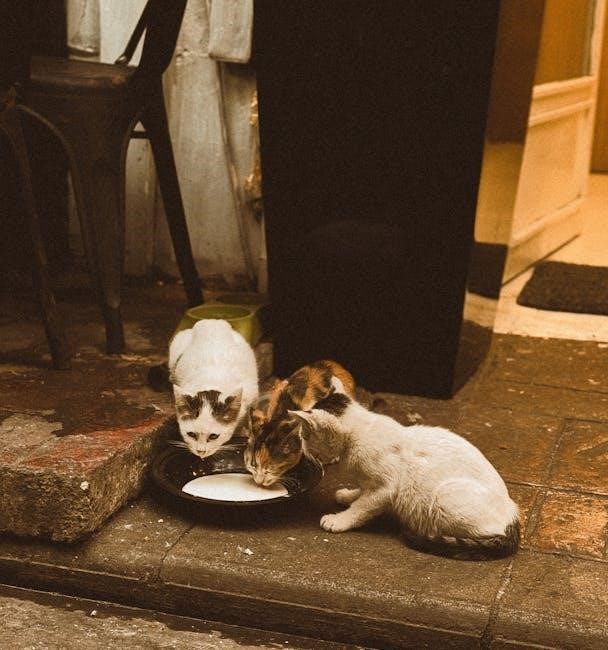
Types of KMR
KMR is available in two convenient forms: powdered and liquid․ Powdered KMR requires mixing with water, offering flexibility, while liquid KMR is pre-mixed for ease of use․ Both provide essential nutrients for kittens․
3;1 Powdered KMR
Powdered KMR is a popular choice for feeding kittens, offering flexibility and convenience․ It requires mixing with warm water according to the instructions, ensuring a fresh batch is prepared for each feeding․ This form is cost-effective and allows caregivers to adjust the consistency as needed․ Many brands, like Royal Canin, offer powdered KMR with tailored nutrient profiles to support growth and development․ Proper preparation is crucial to prevent bacterial growth and ensure the formula remains safe for consumption․ Powdered KMR is often preferred by foster caregivers who need to manage multiple kittens or adjust feeding schedules frequently․ It is also easy to store and has a longer shelf life compared to liquid formulas, making it a practical option for many kitten caregivers․ Always follow the manufacturer’s guidelines for mixing and storage to ensure optimal nutrition for the kittens․
3․2 Liquid KMR
Liquid KMR is a convenient and ready-to-use option for feeding kittens․ It eliminates the need for mixing, providing a quick solution for busy caregivers․ Pre-mixed formulas, such as PetAg KMR Liquid, closely mimic a mother’s milk, offering essential nutrients like proteins, fats, and vitamins․ Liquid KMR is ideal for kittens that require immediate feeding or for those who are particularly fussy․ It is also a good choice for caregivers who prefer ease of use and minimal preparation time․ However, it is important to store liquid KMR properly in the refrigerator after opening and discard any unused portion within a few days․ Always ensure the formula is at room temperature or slightly warmed before feeding to ensure the kitten’s comfort and safety․ Liquid KMR is a reliable option for providing kittens with the nutrition they need for healthy growth and development․
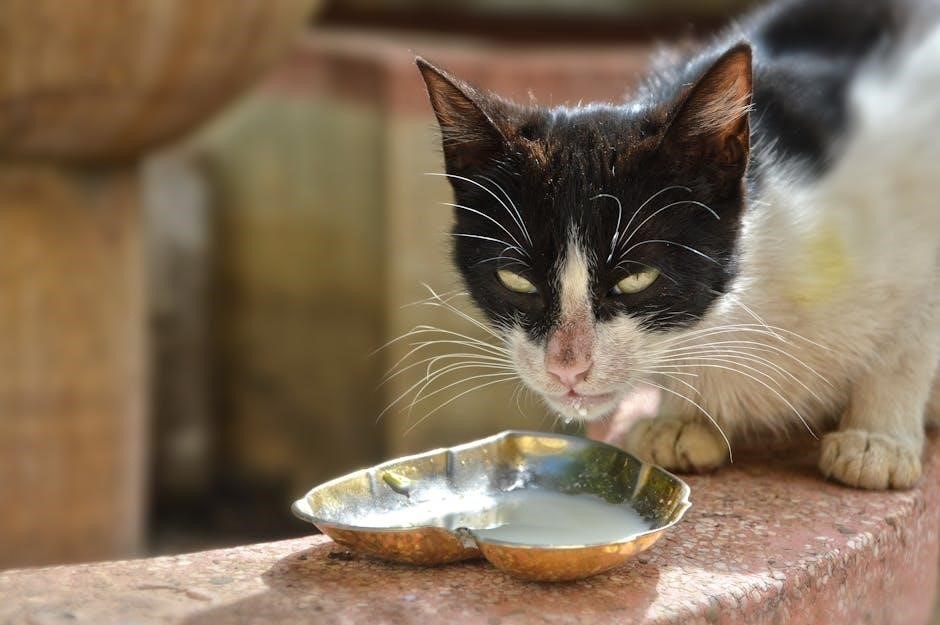
Preparation Instructions
KMR should be prepared by mixing 1 part powdered formula with 2 parts warm water․ Shake or whisk until well dissolved․ Avoid using a blender and ensure the mixture is at body temperature before feeding․
4․1 Mixing KMR

Mixing KMR requires precision to ensure proper nutrition for kittens․ Start by using the provided scoop to measure one part of powdered KMR․ Gradually add it to two parts of warm water, whisking continuously to prevent lumps․ Avoid using a blender, as it can introduce air bubbles, potentially causing digestive issues․ Ensure the mixture is smooth and free of clumps before feeding․ If using liquid KMR, simply pour the recommended amount into the feeding bottle without additional preparation․ Always check the temperature by dripping a small amount onto your wrist—it should feel warm but not hot․ Proper mixing is crucial to provide kittens with the right balance of nutrients for healthy growth and development․ Improper mixing can lead to digestive problems or nutritional deficiencies, so adherence to instructions is vital․
4․2 Temperature Control
Temperature control is critical when preparing and feeding KMR to kittens․ The formula should be warmed to body temperature, approximately 98°F to 100°F (37°C to 38°C), to mimic a mother’s milk․ Excessive heat can harm the kitten, while cold formula may not digest properly․ To achieve the correct temperature, warm water in short intervals, such as 15 seconds per 1/4 cup in the microwave, and mix with KMR powder․ For prepared KMR, reheat it gently, testing the warmth on your wrist before feeding․ Avoid overheating, as it can destroy essential nutrients and potentially burn the kitten․ If the formula is too cold, it may cause discomfort or refusal to feed․ Always ensure the temperature is comfortable and safe before offering it to the kitten․ Proper temperature control ensures optimal digestion and prevents health issues․
4․3 Storage Tips
Proper storage of KMR is essential to maintain its quality and safety for kittens․ Unopened powdered KMR should be stored in a cool, dry place, away from direct sunlight and moisture․ Once opened, the powder should be kept in an airtight container to prevent spoilage and exposure to air․ Mixed KMR must be refrigerated immediately and used within 24 hours․ Discard any leftover formula after this period, as it can spoil and harm the kitten․ Never leave prepared KMR at room temperature for extended periods, as bacterial growth can occur․ For liquid KMR, follow the expiration date on the packaging and store it in the refrigerator after opening․ Always check the formula for any signs of spoilage, such as an off smell or appearance, before feeding․ Proper storage ensures the formula remains nutritious and safe, supporting the kitten’s healthy growth and development․
Feeding Guidelines
Feeding guidelines for KMR vary by age and weight․ Kittens under 6 weeks typically eat every 2-3 hours․ As they grow, feedings can be spaced out․ Always consult a vet for personalized advice․
5․1 Feeding Charts
Feeding charts for KMR provide a clear guide for caregivers, ensuring kittens receive adequate nutrition․ Typically, these charts outline the age, weight, and daily KMR intake․ For example, newborn kittens (0-1 week) may require 1-2 teaspoons per feeding, while older kittens (4-6 weeks) need larger amounts․
| Age in Weeks | Average Weight | CC of KMR per Day | Feedings Per Day |
|---|---|---|---|
| 0-1 | 3-4 oz | 6-8 cc | 8-10 |
| 1-2 | 4-6 oz | 10-12 cc | 6-8 |
| 2-3 | 6-8 oz | 12-15 cc | 5-6 |
| 4-6 | 8-12 oz | 15-20 cc | 4-5 |
These charts serve as a starting point, but individual needs may vary․ Always monitor the kitten’s weight and overall health, adjusting portions as needed․ Consult a veterinarian for personalized feeding plans to ensure optimal growth and development․ KMR feeding charts are essential tools for caregivers, helping to provide balanced nutrition and promote healthy growth in kittens․
A proper feeding schedule is crucial for kittens to ensure they receive consistent nutrition․ Newborn kittens (0-2 weeks) need feeding every 2-3 hours, including overnight, to mimic their mother’s natural feeding pattern․ This frequent schedule supports their rapid growth and high energy needs․ As kittens grow, the frequency can gradually decrease․ For example, kittens aged 2-4 weeks can be fed every 3-4 hours, while those aged 4-6 weeks can be fed every 4-6 hours․ Always warm the KMR to body temperature (around 98-100°F) before feeding to ensure comfort and proper digestion․ It’s important to track each feeding session to monitor intake and adjust as needed․ A well-structured feeding schedule helps prevent overfeeding or underfeeding, both of which can lead to health issues․ By maintaining a consistent routine, caregivers can support the kitten’s development and overall well-being․ Regular weigh-ins and observational checks are key to ensuring the feeding schedule meets the kitten’s needs․ The frequency of feeding kittens with KMR depends on their age and developmental stage․ Newborn kittens (0-2 weeks) require feeding every 2-3 hours, including overnight, to mimic their mother’s natural feeding pattern․ This frequent schedule ensures they receive adequate nutrition for rapid growth and energy needs․ As kittens grow, the feeding frequency can be gradually reduced․ For example, kittens aged 2-4 weeks can be fed every 3-4 hours, while those aged 4-6 weeks can be fed every 4-6 hours․ It’s important to monitor their weight and overall health to determine if adjustments are needed․ Overfeeding or underfeeding can lead to health issues, so consistency and observation are key․ Always warm the KMR to body temperature (around 98-100°F) before feeding to ensure comfort and proper digestion․ By maintaining a consistent feeding frequency, caregivers can support the kitten’s healthy development and overall well-being․ Regular weigh-ins and observational checks are essential to ensure the feeding plan meets the kitten’s needs․ Common mistakes include overfeeding, improper mixing, and incorrect storage, which can lead to health issues․ Always follow the instructions to ensure proper nutrition and hydration for the kittens․ Overfeeding is a common mistake that can lead to serious health issues in kittens․ It can cause diarrhea, dehydration, and weight-related problems, which may affect their long-term health․ Signs of overfeeding include lethargy, vomiting, and poor digestion․ Always follow the recommended feeding charts and monitor your kitten’s weight and behavior․ Avoid adding extra formula beyond the instructed ratio, as this can overload their system․ If you notice any adverse reactions, consult a veterinarian immediately․ Proper portion control ensures kittens receive the right amount of nutrients without overwhelming their delicate digestive systems․ Overfeeding can also strain their liver and kidneys, which are still developing․ Stick to the feeding schedule and avoid offering extra meals between feedings․ Remember, kittens grow rapidly, and their dietary needs change quickly, so regular monitoring is essential․ By adhering to the guidelines, you can prevent overfeeding and keep your kittens healthy and thriving․ Improper mixing of KMR is a common mistake that can lead to health issues in kittens․ Using too much or too little powder can result in a formula that is either too concentrated or too diluted, causing digestive problems or malnutrition․ Always follow the manufacturer’s instructions for the correct ratio of powder to water․ Using cold water can prevent proper dissolution, while overheating can destroy essential nutrients․ Shake or stir thoroughly to ensure the formula is smooth and even․ Avoid using a blender, as it can introduce air bubbles, leading to gas or discomfort in kittens․ Proper mixing ensures the formula is safe and nutritious, promoting healthy growth and digestion․ If the mixture is lumpy or separated, it can cause choking or refusal to feed․ Always discard any unused or improperly mixed formula after 24 hours․ Correct preparation is vital for your kitten’s well-being and development․ Incorrect storage of KMR can lead to spoilage and contamination, which may harm your kitten’s health․ Always store powdered KMR in a cool, dry place to maintain its nutritional integrity․ Once mixed, KMR should be refrigerated immediately and used within 24 hours․ Avoid leaving mixed formula at room temperature for extended periods, as bacteria can multiply rapidly, especially in warm environments․ Do not freeze KMR, as this can alter its consistency and nutrient balance․ Keep the container tightly sealed to prevent moisture and air from affecting the powder․ Proper storage ensures the formula remains safe and effective for feeding․ If you notice any signs of spoilage, such as an off smell or slimy texture, discard the formula immediately․ Always prioritize fresh, properly stored KMR to provide your kitten with the best nutrition possible․ Remember, improper storage can compromise the quality and safety of the formula, risking your kitten’s health․ KMR supports kittens’ overall health by providing essential nutrients, but monitor for allergies or digestive issues․ Consult a veterinarian if your kitten shows signs of sensitivity or adverse reactions to the formula․ While KMR is formulated to meet kittens’ nutritional needs, some kittens may develop allergies or sensitivities to certain ingredients․ Common signs include digestive issues like diarrhea, vomiting, or skin rashes․ If you notice these symptoms, consult your veterinarian to identify the allergen and adjust the diet accordingly․ They may recommend alternative formulas or supplements to ensure the kitten’s nutritional needs are met without triggering adverse reactions․ Always monitor your kitten’s health closely when introducing KMR, as early detection of sensitivities can prevent more severe complications․ Proper veterinary guidance is essential to address any allergic reactions and ensure the kitten’s well-being․ Kittens fed with KMR may occasionally experience digestive issues, such as diarrhea or constipation, which can be caused by improper mixing, overfeeding, or individual sensitivities․ It’s important to ensure the formula is mixed correctly, following the instructions on the container, and that the feeding schedule aligns with the kitten’s age and weight․ If digestive problems persist, consult a veterinarian to rule out underlying health conditions․ They may recommend probiotics or a temporary switch to a different formula to ease digestion․ Always monitor the kitten’s stool quality and overall behavior, as these can indicate whether the current feeding plan is suitable․ Proper digestive health is crucial for a kitten’s growth and development, so addressing any issues promptly is essential․ By maintaining a consistent and balanced feeding routine, you can help prevent common digestive concerns and support your kitten’s overall well-being․ Weaning kittens involves gradually introducing solid food, starting around four weeks of age․ Mix KMR with high-quality wet food to ease the transition, reducing reliance on the formula as kittens adapt to solids․ The transition to solid food for kittens typically begins around four weeks of age․ Start by mixing a small amount of high-quality, nutrient-rich wet kitten food with KMR․ This creates a familiar taste and texture, easing the switch․ Gradually increase the proportion of solid food while reducing the KMR over 7-10 days․ Offer small, frequent portions to prevent overwhelming the kitten․ Monitor their eating habits and stool quality to ensure a smooth transition․ If the kitten shows signs of digestive upset, slow the process․ By 8-10 weeks, most kittens should be fully weaned and eating solids independently․ Always consult a veterinarian if there are concerns about the weaning process or the kitten’s health․ Proper nutrition during this period is crucial for their growth and development․ Patience and careful observation are key to a successful transition․5․2 Feeding Schedule
5․3 Feeding Frequency
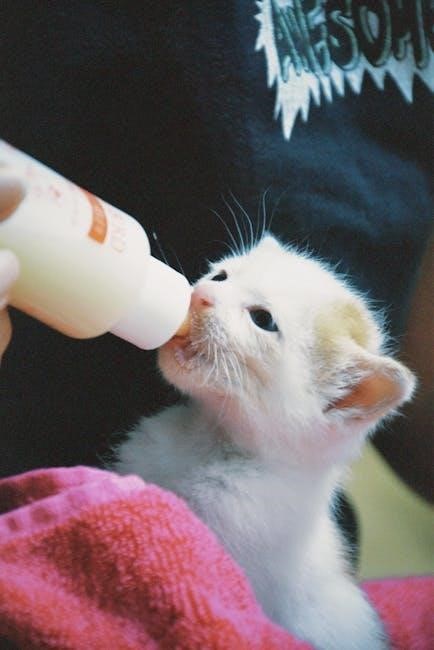
Common Mistakes to Avoid
6․1 Overfeeding
6․2 Improper Mixing
6․3 Incorrect Storage
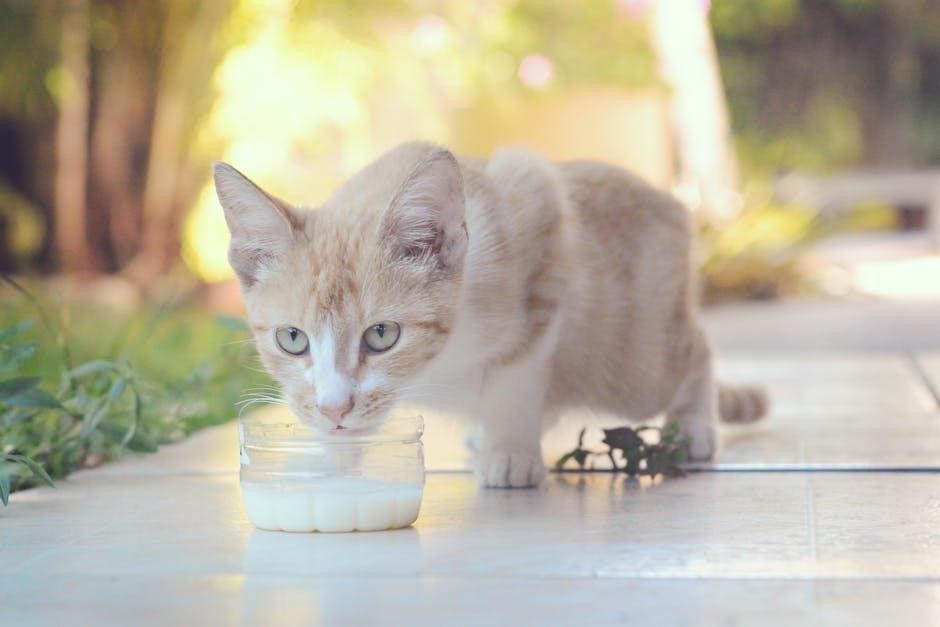
Health Considerations
7․1 Allergies and Sensitivities
7․2 Digestive Issues
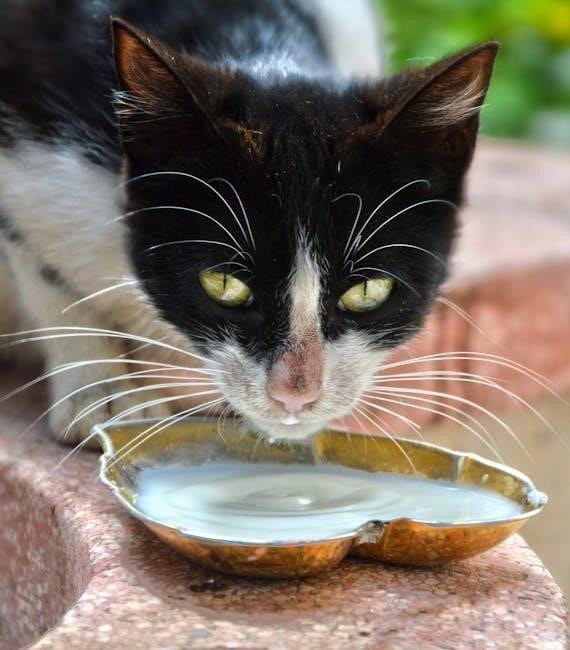
Weaning Kittens
8․1 Transition to Solid Food
